Early teams chase growth. Smart teams chase proof. Two simple signals tell the real story: churn and retention. Churn shows who leaves and why. Retention shows who stays and how often they come back on their own. When you track these with care, you can prove your product gives steady value—even before big revenue shows up.
This guide shows you how to measure, improve, and present churn and retention in plain terms. You’ll learn what to count, how to fix leaks, how to raise the “come back” rate, and how to turn these numbers into a calm, fundable story. We’ll keep it simple and hands-on, with steps you can run this week.
If you want help turning your core loop into real IP while you tighten these metrics, Tran.vc invests up to $50,000 in in-kind patent and IP services for AI, robotics, and deep tech teams. Apply anytime at https://www.tran.vc/apply-now-form/.
Define the Two Signals
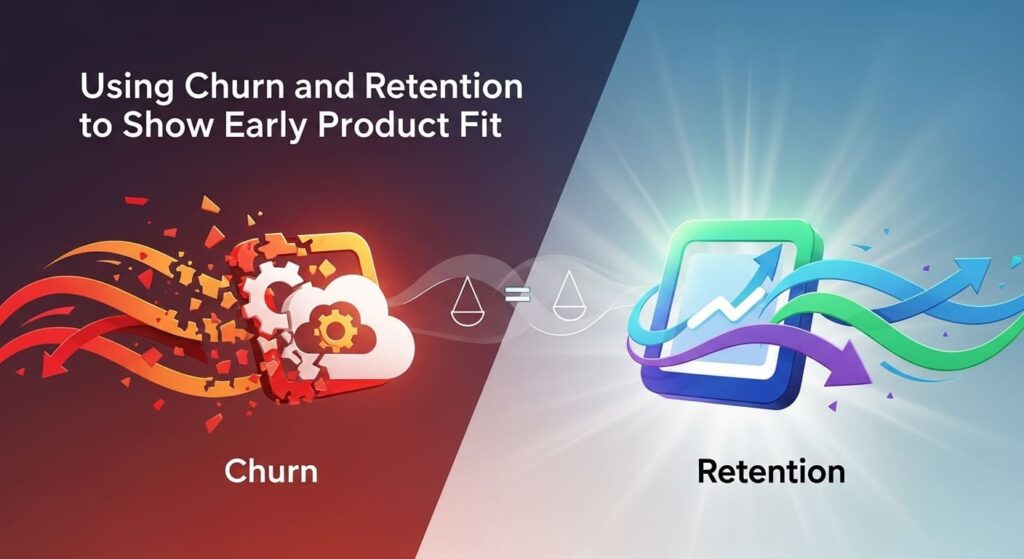
Churn and retention sound like big words. They are simple. Churn is leave. Retention is stay. These two show if your product gives steady value. When you name them in plain words and tie them to real actions, your team knows what to fix next.
What churn means in your world
Churn is when a user or an account stops getting value. It can be a cancel. It can be a quiet fade. You must choose one clean rule. Pick a rule that fits how your tool is used. Say it in one line so there is no debate later.
In AI and robotics, churn can hide. A plant may keep a license but stop using a feature. A lab may pause a workflow and forget to restart. Count that as churn if the core job is not done again. Use behavior, not billing, as your truth at pre-seed.
When the rule is clear, the number becomes helpful. You can point to a moment and say, “Here they left.” That moment is where you learn. It is also where your fix begins. The fix may be a preset, a safer check, or a better handoff. Your rule reveals the right fix.
What retention means in your world
Retention is the share who return and do the real job again. Define “active” with care. It should be the core task, not a login. If your value is a scan that catches faults, active means a scan that finds or clears faults with trust.
Pick a time frame that fits use. Daily tools can use day seven and day thirty. Weekly tools can use week four and week eight. Heavy systems often use months. The key is to be honest about the rhythm of your buyer’s work.
When you track real activity, you avoid vanity. The number may look smaller at first. It will be stronger. A strong, true number is the base of a fundable story. It is also the map for your next sprint.
Why these two beat “more users”
More users can hide leaks. A big top of funnel can make the chart look pretty while people slip out the side. Churn and retention show the bucket itself. If the bucket holds water, new users help. If it leaks, new users just make a mess.
Investors trust teams that face leaks fast. A clear churn rule and a plain retention curve say you are in control. They also say your growth will not collapse when ad spend stops. That calm tone stands out at pre-seed.
These signals also guide IP. If a method keeps people active and prevents exits, protect it. File around the loop that turns “first try” into “second win.” That loop is your moat. Tran.vc helps you lock that down while you grow. You can apply any time at https://www.tran.vc/apply-now-form/.
Measure Cleanly From Day One
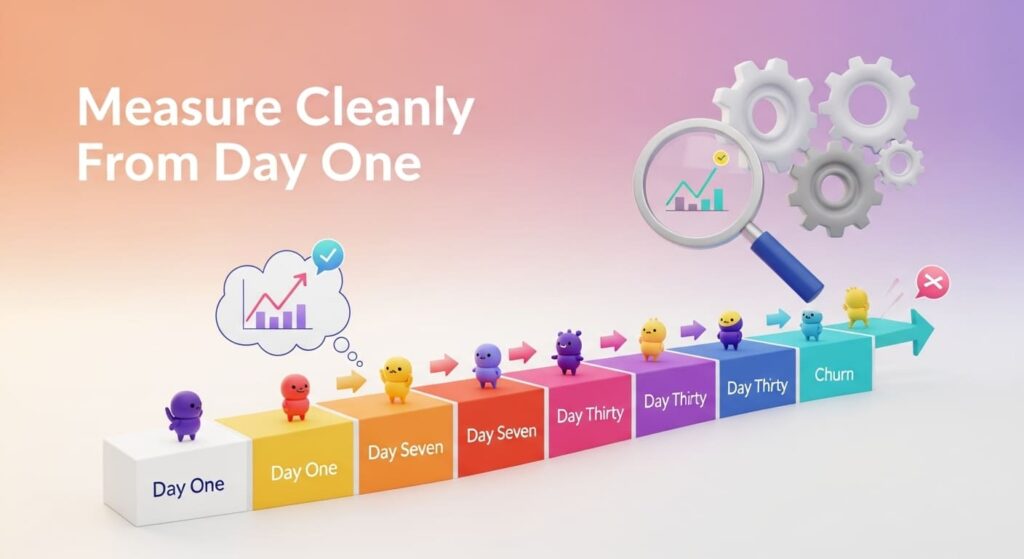
Good numbers come from simple, steady habits. You do not need a big stack. You need clean events, small cohorts, and the same rules each week. This makes trends clear and fixes obvious.
Set one activation and one active event
Your activation event is the first real win. Your active event is the repeat of that win. Both should match the job to be done. If your tool flags defects, activation might be first flagged defect on a real part. Active might be any flagged or cleared result on a live run.
Write the event names in your tracker with exact words. Add them to your product review doc. When everyone uses the same labels, you avoid confusion. You also make it easy to compare weeks and see if changes help.
Do not change these often. If you must, say why and when. Keep a short log of event changes. This protects trust with your team and with partners who read your updates.
Use cohorts, not running totals
A cohort is a group that started in the same window. Track what share stays active over time for that single group. This shows the true curve. Running totals mix old and new users and blur the truth.
Start with weekly cohorts. They are simple and fast to read. If your cycles are slow, monthly can work. What matters is that each cohort has the same chance to succeed. Apples to apples is the rule.
Plot each cohort as a line. Look for the “flat tail” where the line settles. That tail is the core who love the product. Your job is to lift that tail with product, not with hype. The chart will tell you if you did.
Separate users from accounts
In deep tech, a team can churn even if a few users poke around. Track both. User retention tells you about habit. Account retention tells you about revenue risk. Both are useful and often move for different reasons.
Define an account as active when the team does the core job, not when one person logs in. A single curious click should not keep an account in the “stay” bucket. Be strict. Strict now saves pain later.
When you present, bring both lines and say why each moved. This level of clarity is rare. It shows you know how your product is really used and how buying works in your market.
Read the Curve Like a Builder
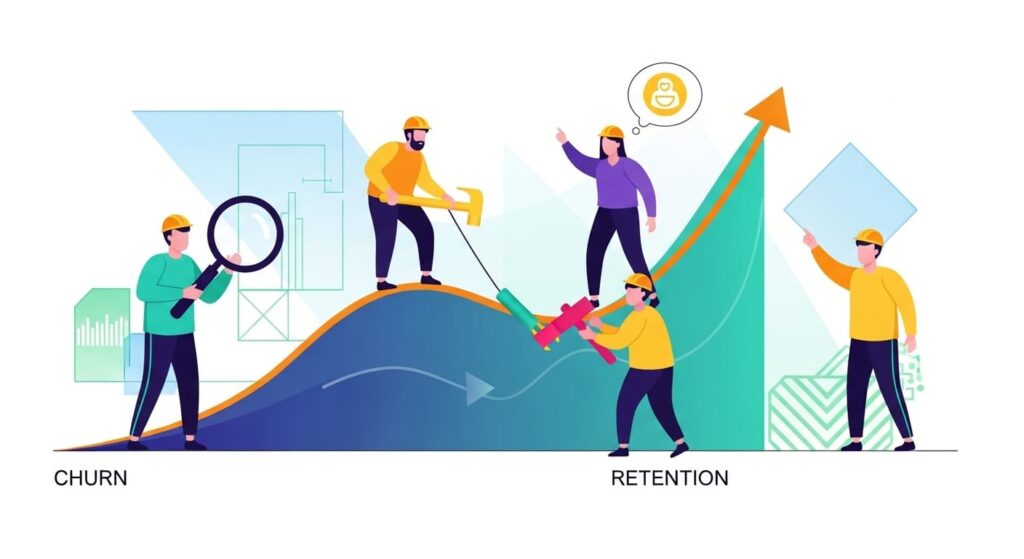
Numbers are only useful if they guide action. Learn to read shapes, not just points. The curve tells you where to push. It also tells you when to stop fixing one thing and move to the next.
Watch the first drop and the flat tail
Most curves fall fast, then slow. The first drop is onboarding pain. The flat tail is true love. If the first drop is steep, fix setup. If the tail is low, fix core value. This simple split keeps work focused.
In robotics, the first drop often comes from device setup and safety steps. In AI, it often comes from data prep and model trust. Your fixes will differ, but the pattern is the same. Smooth the start, then deepen value.
Aim to raise the tail a little each month. Do not chase a spike. Small, steady lifts compound. They also hold when you ship new features, which means your base is strong.
Segment by role, use case, and channel
Different roles behave differently. A technician returns more than a VP. A lab lead cares about morning runs. A quality manager cares about weekly reports. Plot each group. You will see where fit is real.
Use case matters, too. One job may stick while another does not. Keep the sticky one as your wedge. Show investors that this wedge retains at a high rate. This says you found a path to product fit, not just noise.
Channel matters last. Warm intros often retain better than cold ads. That is fine. Use warm paths while you fix cold flow. Do not mask a weak product with paid traffic. The curve will tell on you either way.
Find causes, not just correlations
When a line moves, write down what changed. Did you add presets? Did you add a safer fallback? Did you cut steps? The cause is your lesson. It turns into a playbook you can repeat.
If two things changed at once, try to isolate next time. The point is to learn which lever moves the curve. Each clear win becomes a slide in your deck and a block in your moat.
Share these wins with dates. Dates build trust. They show you did not cherry-pick. They also make follow-up easy because people can match your notes to your releases.
Reduce Churn With Real Fixes

Churn is not a moral failing. It is a message. Treat it with respect. Go back to the moment people left and make that moment safer and faster. Small, real fixes beat big, vague plans.
Find the exit moment and remove one step
Read logs for the last session before churn. Watch where people paused. It is often a data import, a device pairing, or a scary “run” button. Replace one hard step with a preset or a safe preview.
If import breaks, ship a sample set that mirrors a real site. If pairing fails, build a guided flow with checks. If “run” feels scary, add a dry run that shows the result without risk. Each fix should shave fear or time.
Report the change and re-measure the next two cohorts. If churn drops in week one, you found a lever. If not, pick the next exit step. This calm loop is how buckets stop leaking.
Add guardrails that users can trust
People churn when they do not trust outcomes. Add clear signals for confidence and drift. Slow the system when inputs look wrong. Ask for a review before risk. Users will stay when they feel safe.
In AI, show why a result is low confidence and offer a safe next step. In robotics, show a virtual path before motion. These moves sound small. They change behavior. They turn fear into habit.
Protect guardrails in your IP if they are novel. A method that keeps value steady is a core asset. It is worth claims. It is worth a slide in your deck. Tran.vc helps capture these loops so rivals cannot clone your safety edge.
Close the loop with people who left
Ask for a short call with a clean promise: no pitch, just learning. Keep it to ten minutes. Ask about the last day they used the product and what stopped them. Thank them and leave it there.
If a fix lands that addresses their reason, send one note with a single screenshot. Do not push. Many will try again. Some will not. Either outcome is data. You win by learning, not by forcing.
Log their words in your churn file. Over time, the same two or three reasons will keep showing up. Those reasons become your roadmap until they fade from the notes.
Lift Retention With Faster Wins

Retention grows when people get value faster the second time. Make the path back short. Save context. Stage the next step. Guide without noise. Habits form when friction falls.
Save state like a good assistant
Remember what worked last time. Keep presets, filters, and device settings. Land users where they left off. Offer one button to repeat the last run with fresh inputs.
This is not fluff. It is time. Time is respect. Respect makes people return. Each saved click is a reason to come back tomorrow and the day after.
When saved state cuts time, write down the minutes won. Put that number in your update. This is the kind of micro-proof partners believe. It is also the kind of edge that adds up in real sites.
Surface meaningful nudges
Send only what helps. A weekly digest that shows wins and flags risk is enough. Avoid daily noise. Each message should answer, “Why should I open the app today?”
Tie nudges to the user’s role. A technician needs next steps. A manager needs a summary. A scientist needs accuracy notes. Role-fit nudges feel like help, not spam.
Track return visits after each nudge type. Keep the one that brings people back without spikes that fade. Retention should feel smooth, not jittery. Smooth is what buyers trust.
Turn results into rituals
Make it easy to share outcomes. One click to copy a chart. One click to export a spec. One click to open a ticket. When results feed other work, your product becomes a ritual.
Rituals keep retention high even when schedules change. People build muscle memory around your steps. This is real fit. It is hard to steal once it sets.
If your method creates a unique, shareable artifact, consider filing. Owned formats and flows, when novel and useful, can be part of a moat. Tran.vc can help you decide what to protect and how.
Present Churn and Retention in Your Deck
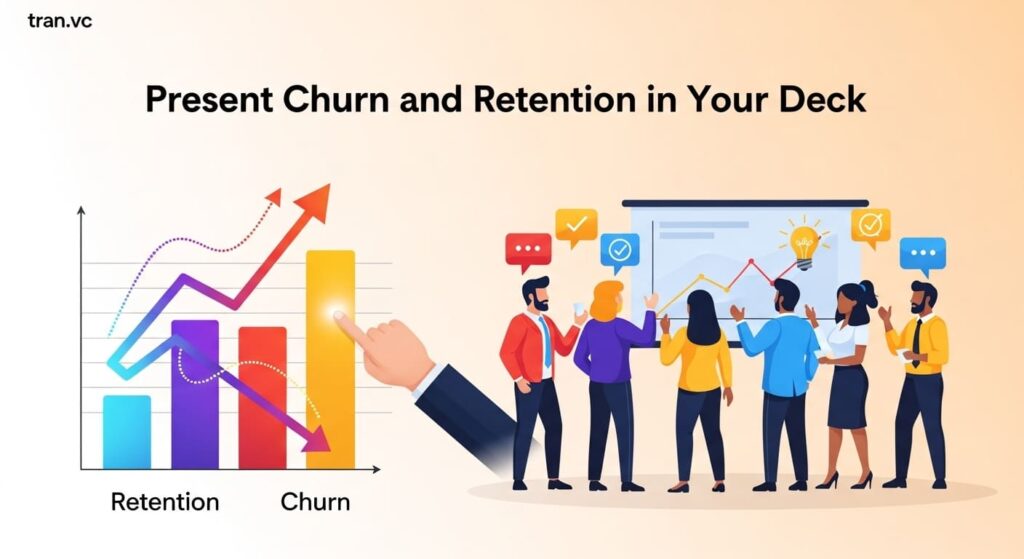
You do not need many slides. You need clear ones. Your goal is to help people see what changed, why it changed, and what you will do next. When the story is simple, the room leans in.
Pick one definition and stick to it
Start with a single line that defines churn and a single line that defines active. Keep the words plain. Put those two lines at the top of the slide so no one argues about terms. This removes friction and buys you time for the real story.
Show a small note on cadence. Say which cohort window you use and why it fits your product rhythm. A week for daily tools, a month for heavy tools, and so on. This shows care without dragging people into a data lecture.
If you ever change a definition, mark the date on the slide. Add one sentence on why. Honest change builds trust. Quiet change breaks it. Investors remember who plays it straight.
Show the curve and the cause
Place a cohort curve with a clear tail. Label two moments where the line improved. Above each, add five simple words naming the fix, like “added safe preview” or “kept presets.” Let the shape and the labels carry the weight.
Say one short sentence for each label: what you changed, what behavior shifted, and how long it took to see the lift. This lets partners feel the loop from insight to release to result. They are not guessing; they are seeing.
End the slide with your next move. Name the change and the metric it should move. When you follow up in a month with the new dot on the same chart, you look steady and in control.
Pair proof with a human voice
Add one real quote near the chart. Keep it short and keep it raw. “Dry run made it safe to try on shift.” Real words stick. They also de-risk your numbers because they sound like the floor, not the ceiling.
If allowed, include a small, redacted screenshot under the quote. Screens beat stock art. They show your product in the real world without breaking privacy. This is what many rooms want: proof that feels honest.
Close with a quiet line about IP if the lift came from a unique method. “Tail rose after adding glare-safe planner (provisional filed).” This ties traction to moat in one breath.
Build a Weekly Metric Rhythm

Numbers help only when they change what you do. A light, steady rhythm keeps the team focused and stops long debates. You are building a habit that compounds.
Run a 20-minute metrics standup
Meet once a week at the same time. Open with your two definitions so new people stay aligned. Show the newest cohort’s churn and retention lines. Do not add ten other charts. Focus keeps speed.
Ask three questions in order. What moved? Why did it move? What will we ship before next week? Capture the answers in one short note with dates. The note is your memory and your promise.
End on a single owner per action. Names beat teams. Dates beat ranges. Next week, you will check the action first. This loop pulls the company forward without drama.
Make logs part of the work
Instrument the one activation event and the one active event. Log times and outcomes. Do not log everything; log the few things that matter to your two lines. Less tracking, better usage.
Teach the team to add a log line when they ship a change that should touch churn or retention. A small, consistent label lets you read effect without hunting through commits.
Review logs in the standup only when a line moves. Otherwise, leave them be. Logs are tools, not a show. Your culture should treat them that way.
Share a simple update outside the team
Send a short, monthly note to advisors and friendly investors. Include the two curves, two causes, and one next move. Keep it to one screen. Busy people will actually read it.
Reply to any follow-up with facts, not fluff. If someone asks “what is active,” paste your one-line definition. If they ask “what changed,” paste the dated release note. Consistency raises trust.
Add your CTA when it fits. “We’re seeking two plants running two shifts to test the new safe preview.” Good updates invite help that moves your lines, not random introductions.
Link Churn Fixes to Pricing Tests

When you fix churn, you usually remove fear or cut time. That change has price in it. Tie them together so your offers grow stronger as your product gets smoother.
Turn each fix into a promise
If a safer preview dropped churn, promise “first safe run in minutes” and mean it. Put that promise on your pilot sheet and track it during the engagement. Buyers pay for certainty.
When you keep a promise, write the exact before-and-after in a one-pager. Share it with your champion. They will forward it up the chain because it makes them look good. That forward is your price air cover.
If you miss a promise, own it. Say what you learned and the guardrail you added. Then adjust the pilot scope or the fee. Straight talk here saves deals that wobbled.
Move from time saved to dollars earned
Estimate the cost of what churn used to cause. Minutes of re-teach, parts scrapped, downtime per swap—use the numbers your logs and interviews gave you. Turn those into a simple monthly value range.
Price the plan as a small slice of that value. Keep the unit that fits the buyer’s world: per line, per device, per team. When your fix is real, the math will feel fair without a long fight.
As you collect proofs, lift the price gently on new deals. Show the same before-and-after chart and the same promise. Better retention often earns better price because trust is higher and risk is lower.
Keep free trials rare and tight
Free periods invite drift and mask churn. If a trial is needed, keep it short and scoped to the exact promise your fix supports. Tie it to one metric and one owner on the buyer side.
Send a two-sentence, twice-a-week note during the trial with a screenshot and the number. The rhythm makes the value visible and keeps the trial from growing fuzzy.
Convert the trial to a small, paid step the moment the promise is met. Do not let success float. A clear success should become a clear invoice while everyone feels the win.
Use Partners to Boost Retention Without Heavy Spend
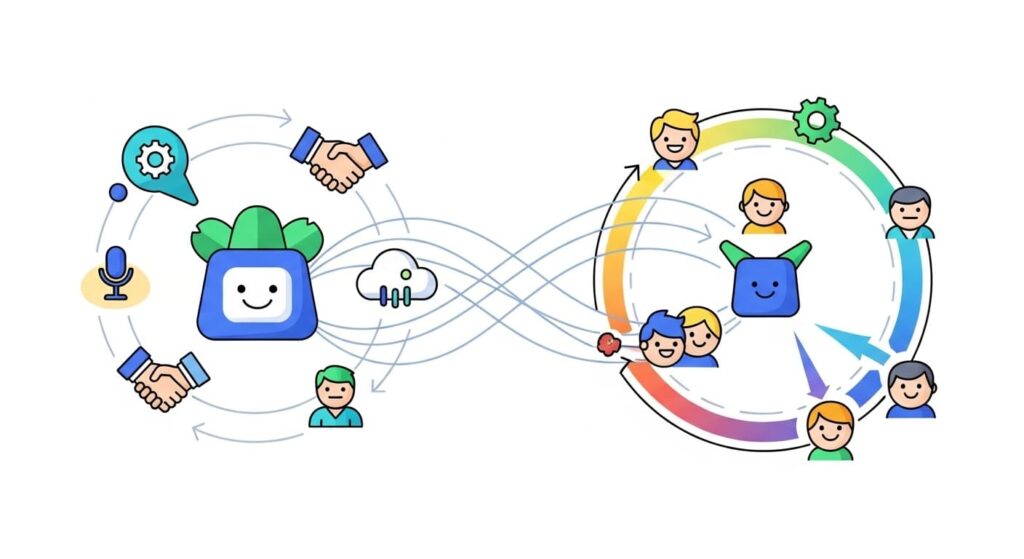
The right partner can raise your “come back” rate by reducing setup pain and sharing trust. Start small, protect your core, and make the joint proof easy to repeat.
Pick partners that live where churn happens
Look for integrators, device vendors, or VARs who sit at the painful step your logs flagged. If churn spikes at camera setup, partner with the team that mounts and calibrates cameras.
Ask for one very specific intro to a site that matches your wedge. Avoid broad promises. You want a single scene where your joint work can shine in days, not months.
Share a tiny enablement pack that names your activation event, your active event, and the guardrails. Partners help best when they know your definitions and your safety lines.
Co-design one retention lift
Scope a joint move that removes a step or adds a safety check. Keep it boring and fast. A preset, a jig, a short checklist—these small things change behavior.
Run it on one line with one owner on each side. Measure your two lines before and after. If the tail rises, you have a repeatable move. If it does not, you learned fast and can adjust.
Wrap the win in a neutral, client-approved note. Two paragraphs, one chart, one sentence on the method. Neutral proof spreads inside both orgs and unlocks the next site.
Guard your method and tell the story
Keep your core logic in your box. Share outcomes, not internals. Clear partner terms should protect your IP and your data even as you collaborate in the field.
If the joint move uses a novel method you built, file quickly. Claims around the method that lifts retention will keep your edge as the partner program grows. This is how channels scale without erasing your advantage.
On your next raise, put the joint note beside your curve. “Retention rose after partner-led setup preset (claims filed).” Few lines tell a stronger story.
Build a Retention-First Roadmap

A roadmap should protect what keeps people coming back. When you plan with retention in mind, every sprint defends habit. Small, steady lifts beat flashy launches that fade after a week.
Choose one wedge to defend first
Pick the use case with the strongest tail on your cohort chart. This is where users already return without push. Name the job in one line and put it at the top of the roadmap so the team sees the target every day. Focus brings speed and lowers risk, because you improve a loop that already works.
Map the steps from first open to second win for this wedge. Write each step as a verb a user does, not a screen you show. Verbs expose friction. Screens hide it. When you write verbs, the fix often becomes obvious, like “auto-fill last good settings” or “show dry run before live run.”
Commit the next two sprints to removing one step each. Do not add new paths until the core path is clean. Retention rises when you remove reasons to leave. It rarely rises from extra features alone. This discipline turns a good wedge into a real beachhead.
Prioritize work by impact on the flat tail
The “flat tail” is the share who stay after the first drop. Rank your backlog by which items raise that tail, not by loudness or novelty. If an item saves a repeat user ten minutes a day, it belongs high. If it delights once but adds no speed or safety later, park it.
Estimate tail lift with a simple test. Ask, “Will this make the second run faster, safer, or clearer?” If the answer is yes to two of the three, it is worth a try. If the answer is no, it might be nice, but it will not move the number you care about now.
Review tail results every Friday. Keep a tiny table: item, ship date, predicted lift, observed lift. When you are wrong, say so and learn. When you are right, encode the pattern into your playbook so the next similar item is easier to pick.
Bake safety and defaults into the core loop
Return visits die when users feel risk. Add guardrails where mistakes happen. Use dry runs, soft stops, and clear confidence signals. These do not slow power users; they free them. When the tool protects them, they trust it and come back.
Defaults carry more weight than docs. Set safe, smart defaults based on the last good run. Preload a template that matches the most common scene. Defaults let people win without thinking. Wins build habit. Habit is retention.
If your guardrail or default logic is novel, capture it. Write the flow in plain steps: inputs, checks, actions, fallbacks. When those steps are new and useful, they are claimable. This is how you turn retention lifts into IP you own, which helps you raise with leverage later.
Instrument Only What Matters (and Respect Users)
You do not need heavy tracking. You need a few clean events that tell the truth. Good instrumentation guides work, protects privacy, and makes updates simple.
Log the two events that drive your story
Instrument one activation event and one active event. Record time, role, and context that matters to the job. Skip vanity events. More logs do not mean more insight. They often mean more confusion and more risk.
Add a single “guardrail fired” event. When a dry run, confidence check, or safe stop triggers, log it with a reason code. This tells you where fear lives and whether your safety net helps. It also feeds case stories that are easy to share in sales and raises.
Keep IDs stable across weeks so cohorts are easy to build. If an ID scheme must change, do it once and write the date in your metrics doc. Stability is what turns raw events into trends you can defend.
Build one small dashboard your team actually opens
Make a page with four tiles: newest cohort activation, newest cohort week-four retention, guardrails fired by reason, and top exit moments. That is enough to steer sprints. If a tile does not change action, remove it.
Show numbers and a one-line note on what shipped. Numbers without context cause debates. Notes without numbers cause doubt. Together, they create calm. Calm teams move faster because they argue less about what to do next.
Pin the dashboard in your standup doc. Open it at the start of the weekly review and close it at the end. Do not turn the meeting into a tour. Let the page guide three choices, then go build.
Respect privacy and earn trust
Collect the least data you need to help users win. Mask sensitive fields by default. Limit access by role. Log who looked and when. These basics reduce risk and shorten security reviews.
Be clear in product about what you collect and why. Simple language beats legalese for trust. If a user asks to see their data, show it quickly. If they ask to delete it, do it quickly. Speed here is part of your brand.
If you invent a way to get the same insight with less data, write it up. Methods that reduce data needs while keeping accuracy can be protectable. They also make buyers say yes faster. Both are wins.
Coach Customer Success to Fight Churn

People do not leave because they are lazy. They leave because they get stuck or forget the path. A light, human touch at the right moment keeps them moving and teaches you what to fix next.
Run a crisp, two-call onboarding
Hold a “first win” call. The only goal is to reach the activation event together. Record the steps, then remove as many as you can from the product. Every removed step pays rent in retention.
Hold a “second win” call a week later. This one is about the first repeat. Watch where the user hesitates. Saved state, presets, and dry runs often solve what you see. The second win is the start of habit. Protect it.
Send one short recap after each call with a screenshot and the next step. Keep your words in the user’s language. These small notes become templates your team can reuse at scale.
Add simple health checks and nudges
Define a “healthy account” in one line: e.g., “two active runs per week, guardrails triggered less than 10%.” Check this weekly. If an account falls below, nudge with a helpful note tied to their job.
Make nudges about value, not usage. “Here’s the drift we caught last week” beats “please log in.” Users return for help, not because you asked them to open the app. Use proof, not pressure.
Keep a playbook of three common issues and fixes. For each, include a screenshot, a how-to, and a link to a preset. CS should solve in one reply. If a fix recurs, it belongs in product, not support.
Treat exit interviews as gold
When someone cancels or goes quiet, ask for ten minutes to learn. Promise no pitch. Ask about the last session and what stopped them. Thank them and end on time. Dignity here keeps doors open.
Tag each exit reason in your churn file. After a month, you will see patterns. Pick the top two and aim your next sprints there. Then track whether those reasons drop. That is a real win.
If a fix ships for a specific exit, send a single image and one line to that user. Many will try again. Even if they do not, your note shows care. People talk. Care travels.
Forecast With Churn and Retention (Without Fancy Models)
You can plan the next quarter with a few numbers on one page. Use retention to see who will stay. Use churn to see who will leave. Tie both to your pipeline of real deals.
Build a tiny, honest model
Start with active accounts today. Apply your observed churn rate by month. Do not guess a better number. Use the last two or three months as your guide. Honesty helps you act faster.
Add expected wins from pipeline, weighted by stage. Keep weights simple and strict. If a deal does not have a date and an owner on the buyer side, weight it zero. This rule keeps the model from lying to you.
Layer in the effect of one fix you plan to ship. If a guardrail cut exits by a few points last month, carry that forward one more month. Do not stack many changes. One change is enough to set a target you can hit.
Plan capacity with retention in mind
Retention tells you where support load will fall. Accounts with strong habit need less handholding. Aim CS time at new cohorts and wobbling accounts. This raises the floor without growing headcount.
In product, retention shows where you can safely add features. Do not pile new ideas on a shaky loop. Ship to the wedge that holds users. That is where new modules will stick and expand revenue later.
In infra, use cohort tails to estimate steady usage. Spiky products are costly to run. Smooth tails make cost more predictable. Share this with finance so your burn plan matches reality.
Report with clarity in investor updates
Share one line on churn, one line on retention, and one sentence on the change that moved them. Add a small chart for the newest cohort with two dated labels. Keep it on one screen.
State next month’s move and the metric it should lift. Then do it. When you follow through, trust compounds. Later, when you raise, diligence is faster because your numbers already have a story.
Close with a precise ask tied to your wedge. “Seeking two lines running two shifts to test glare-safe dry run.” Specific asks get specific help. Vague asks get silence.
Turn Retention Loops Into Defensible IP

If a loop keeps people active and rivals cannot copy it easily, protect it. A few smart filings around the engine of habit can hold your ground for years.
Identify loops that are both novel and useful
Look for places where your system behaves differently than others when inputs are messy. Glare, drift, occlusion, sparse labels—if your method handles these with less setup and higher trust, write it down.
Prove utility with logs and quotes. “Guardrail fired on drift; safe path shown; operator approved; run completed.” These tiny stories make a claim stronger and help counsel see the practical value.
Confirm novelty with a quick scan of common approaches. If your steps differ in a key way, you likely have something worth filing. Keep notes in plain language so the whole team can review.
Draft claims in the language of the workflow
Describe inputs, checks, actions, and fallbacks as a flow, not as a code dump. Claims that read like a method are often broader and more durable. They also map cleanly to your product and your metrics.
Include role context when it matters. If your loop changes based on operator role or device state, say so. Field reality often becomes claim strength because it proves your method fits the real world.
File early with a focused provisional. You can add detail as usage grows. The point is to plant a flag on the loop that drives retention. Wait too long and copycats may file around you.
Keep the IP portfolio in lockstep with product
Review claims each quarter against what users love today. Prune ideas that do not map to habit. Expand claims where logs show repeat value. Your moat should reflect the parts users touch most.
Mention IP lightly but clearly in your deck when it connects to a metric lift. “Tail rose after glare-safe loop; provisional filed.” This ties law to traction in one breath. Partners remember that.
Tran.vc works side by side on this. We invest up to $50,000 in in-kind patent and IP services for AI, robotics, and deep tech teams. We help you choose the right loops to protect and shape a story grounded in retention and safety. Apply anytime at https://www.tran.vc/apply-now-form/.
Conclusion
Strong companies do not hide behind big top-of-funnel charts. They show that people come back without a push. Churn and retention make that clear. When you define them in plain words, measure with clean cohorts, and tie every change to a shift in the curve, you prove real product fit. You also prove control. That calm control is what partners and buyers trust.
Keep your loop tight. Help a new user reach a first win, then make the second win faster, safer, and easier. Save state. Add clear guardrails. Remove one step each sprint. Tell the story with dates, quotes, and a simple curve that flattens higher each month. When fixes lower exits and raise returns, link those wins to price and a small, paid step. Your roadmap now protects the habit, not just the demo.
Turn the engine behind that habit into assets you own. If a method makes results safe under glare, drift, or noisy data—and it keeps people active—capture it and file. Tie that filing to the same retention lift in your deck. You are not just growing; you are making your edge hard to copy. That is how you raise well and scale on your terms.
If you want a hands-on partner to help you do this work, Tran.vc invests up to $50,000 in in-kind patent and IP services for AI, robotics, and deep tech teams. We help you pick the wedge, tighten the loop, and protect the method that keeps users coming back. If that is your next step, apply now at https://www.tran.vc/apply-now-form/.
